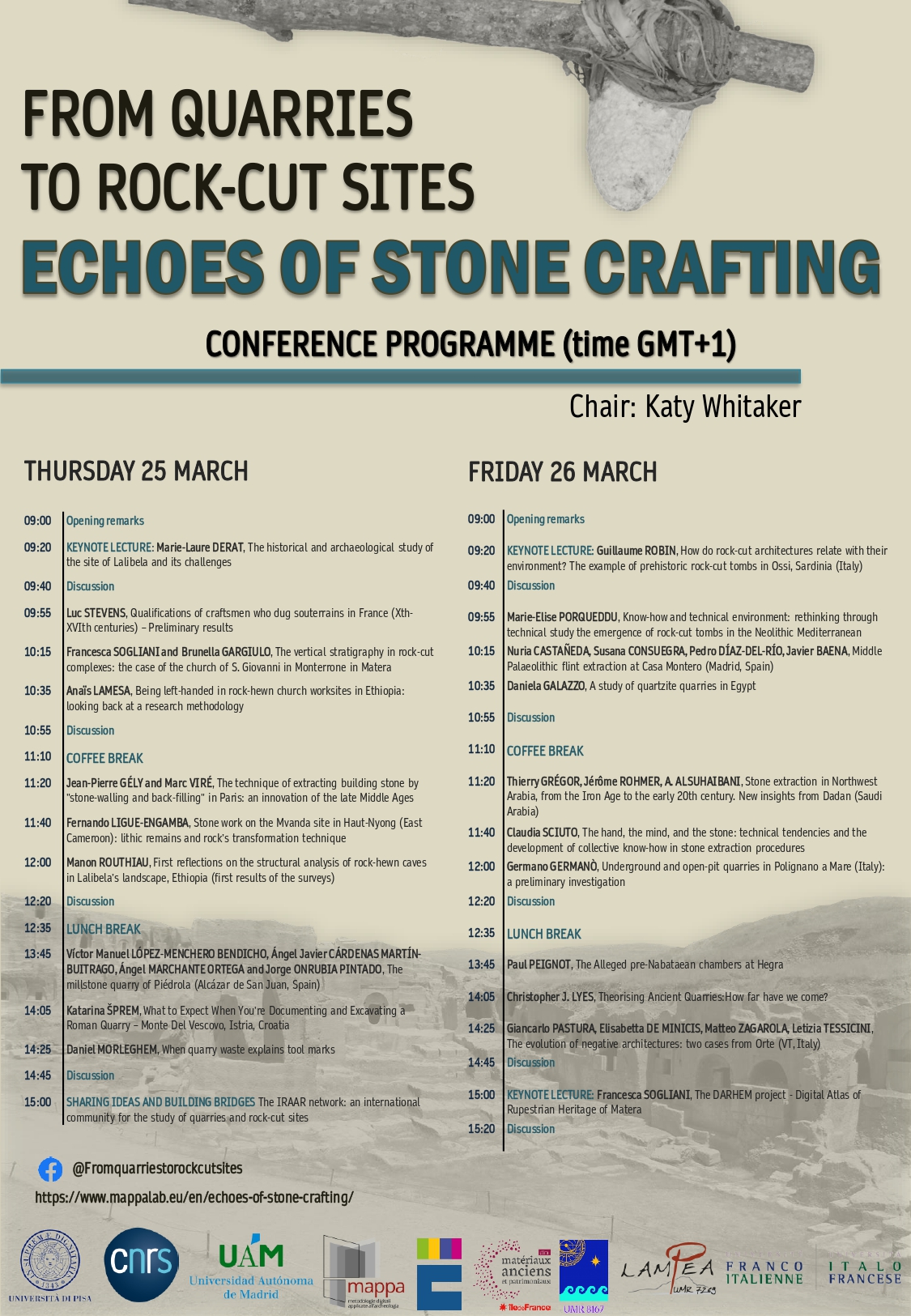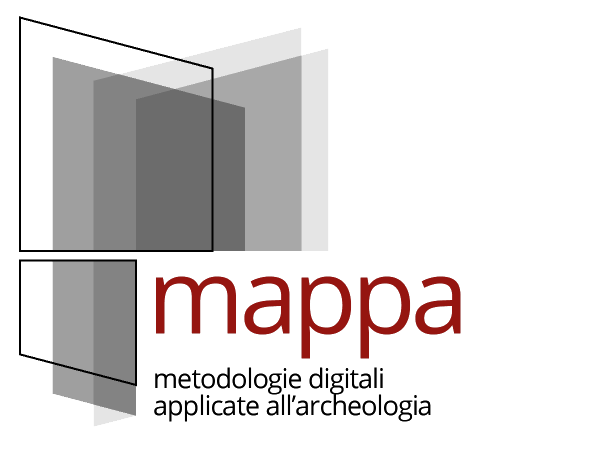FROM QUARRIES TO ROCK-CUT SITES
Echoes of stone crafting
Online conference, 25-26 March 2021
The archaeological study of quarries focuses mainly on the reconstruction of the extraction process, while rock-hewn spaces have often been approached from the point of view architectural styles or art-history. Nevertheless, a holistic structural approach to the study these spaces could allow a better understanding of the agency of those who carved the stone. Stone quarries and rock-cut sites have rarely been included in global studies of historical landscapes and few are the forums dedicated to the theoretical and methodological debate over the importance that these sites have for the understanding of past societies: the conference cycle organized by Marie-Elise Gardel at Saint-Martin-le-Vieil over the past 15 years; the research seminars ” de la carrière à la construction ” coordinated by the Laboratoire de Médiévistique occidentale de Paris (LAMOP – Université Paris-Panthéon Sorbonne); the recent sessions at the conference of the European Association of Archaeologists (2017-2019) and at the symposium of the Society of Italian Medieval Archaeologists (SAMI) which took place in Matera in 2018.
The study of these structures raises many methodological problems for researchers: the subterranean nature of some sites prevents the presence of natural light; the narrowness of the passages makes surveying difficult and the presence of waste piles and big blocks make the observation of quarry fronts extremely difficult. These sites have often been perceived as the result of synchronic processes. Because of that, site layouts have long been the only objects of study, neglecting the analysis of the carving phases and the determination of the relative chronologies. Furthermore, few researchers seem interested in the study of excavation and extraction processes, essential for defining the economy of the sites, identifying and qualifying the human agents who contributed to the creation of this evidences and understanding the
organization and function of the space within the sites themselves.
The conference aims at carrying on the international debate on the archaeological investigation of ROCKCUT SPACES and STONE QUARRIES, considered as aspects of the same mining phenomenon: places in which specific empirical and handcrafted knowledge related to stone working is expressed and conveyed. The conference envisages a diachronic approach and therefore all case studies are welcome, without chronological limits. The meeting will be organized considering two different research
perspectives and observation scales:
– the analysis of the individual rock walls, considering the study of tool traces as a proxy for understanding the carving phases;
– the analysis of the structure (site/quarry) as a whole, by contextualizing the results of the study of the single walls.
The conference will be held on March 25th and 26th, 2021. Official language is English. Due to the current situation and in order to allow everybody to participate, the conference will move online. The event will be hosted on a platform supplied by the University of Pisa and streamed on YouTube and Facebook. The meeting will promote a participated reflection on the methods for documenting spaces that are carved in stone. A moment of exchange at the end of the first day will be devoted to questions of vocabulary, often revealing of different theoretical approaches and traditions of study.
The participation of PhD students and young researchers is encouraged.
PROPOSALS FOR COMMUNICATIONS (ABSTRACT MAX 300 WORDS, 3 TO 5 KEYWORDS AND ONE IMAGE) SHOULD BE SENT IN ENGLISH BEFORE 15 JANUARY 2021 TO IRAARGROUP@GMAIL.COM.
The study of these structures raises many methodological problems for researchers: the subterranean nature of some sites prevents the presence of natural light; the narrowness of the passages makes surveying difficult and the presence of waste piles and big blocks make the observation of quarry fronts extremely difficult. These sites have often been perceived as the result of synchronic processes. Because of that, site layouts have long been the only objects of study, neglecting the analysis of the carving phases and the determination of the relative chronologies. Furthermore, few researchers seem interested in the study of excavation and extraction processes, essential for defining the economy of the sites, identifying and qualifying the human agents who contributed to the creation of this evidences and understanding the
organization and function of the space within the sites themselves.
The conference aims at carrying on the international debate on the archaeological investigation of ROCKCUT SPACES and STONE QUARRIES, considered as aspects of the same mining phenomenon: places in which specific empirical and handcrafted knowledge related to stone working is expressed and conveyed. The conference envisages a diachronic approach and therefore all case studies are welcome, without chronological limits. The meeting will be organized considering two different research
perspectives and observation scales:
– the analysis of the individual rock walls, considering the study of tool traces as a proxy for understanding the carving phases;
– the analysis of the structure (site/quarry) as a whole, by contextualizing the results of the study of the single walls.
The conference will be held on March 25th and 26th, 2021. Official language is English. Due to the current situation and in order to allow everybody to participate, the conference will move online. The event will be hosted on a platform supplied by the University of Pisa and streamed on YouTube and Facebook. The meeting will promote a participated reflection on the methods for documenting spaces that are carved in stone. A moment of exchange at the end of the first day will be devoted to questions of vocabulary, often revealing of different theoretical approaches and traditions of study.
The participation of PhD students and young researchers is encouraged.
PROPOSALS FOR COMMUNICATIONS (ABSTRACT MAX 300 WORDS, 3 TO 5 KEYWORDS AND ONE IMAGE) SHOULD BE SENT IN ENGLISH BEFORE 15 JANUARY 2021 TO IRAARGROUP@GMAIL.COM.

Links for attending the conference
25 morning
https://www.youtube.com/watch?v=_Y4z0_S-RSc
25 afternoon
https://www.youtube.com/watch?v=4tkPf7OBgms
26 morning
https://www.youtube.com/watch?v=YAXJyZdg1Kw
26 afternoon
https://www.youtube.com/watch?v=XfCQv2Y9BIs
Link to attend the plenary meeting of Thursday MArch 25th, at 15.30
(GMT+1)
https://zoom.us/j/93819934525?pwd=RDdEb2ZTUWNmbUV3NFU5UmhiZjI4Zz09
ID: 938 1993 4525
Codice: T9TSLC
In case of problems or for information please write to us: iraargroup@gmail.com
Behind the scenes

